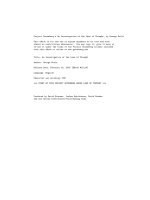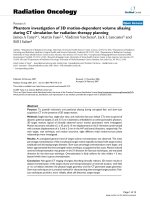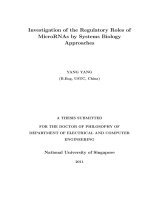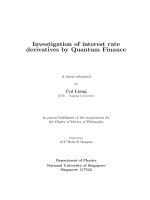Investigation of microtremor motion variation by Nakamura’s H/V spectral ratio method
Bạn đang xem bản rút gọn của tài liệu. Xem và tải ngay bản đầy đủ của tài liệu tại đây (520.82 KB, 7 trang )
Journal of Marine Science and Technology; Vol. 17, No. 4B; 2017: 68-74
DOI: 10.15625/1859-3097/17/4B/12994
/>
INVESTIGATION OF MICROTREMOR MOTION VARIATION BY
NAKAMURA’S H/V SPECTRAL RATIO METHOD
Hung Nguyen-Tien1,2*, Phuong Nguyen-Hong1, 4, Minh Nguyen-Le1,
Wen Kuo-Liang3, Nguyen Tran-An1
1
Institute of Geophysics, VAST, Vietnam
Graduate University of Science and Technology, VAST, Vietnam
3
Institute of Geophysics, National Central University, Taiwan
4
IRD, Sorbonne Universités, UPMC Univ Paris 06, Unité Mixte Internationale de Modélisation
Mathématique et Informatiques des Systèmes Complexes (UMMISCO) 32 venue Henri Varagnat,
93143 Bondy Cedex, France
*
E-mail:
2
Received: 9-11-2017
ABSTRACT: In this study, the variation of microtremor motion is investigated using
observation data in Hanoi and Vung Tau cities. The results of observation conducted by times and
by seismometers are processed using the Nakamura's H/V spectral ratio method and compared. For
investigation, the observations have been conducted with frequency of 27 observations per hour, 22
observations per month, 4 simultaneous observations using both Servo and K2 seismometers, and
12 simultaneous observation using 7 Servo seismometers. The results of data analysis show that the
values of dominant frequency and shapes of the H/V spectral ratio obtained are similar in the
frequency range from 0.4 Hz to 5 Hz, especially on the dominant frequency domain. The results
confirm that the microtremor variation observations can be carried out with one observation time or
by multiple seismometers.
Keywords: H/V spectral ratio (HVSR), microtremor, seismometer.
INTRODUCTION
Microtremor is a natural vibration near
surface with very small amplitude (variation of
amplitude of displacement is about 10-7 to 10-5
m; variation of amplitude of velocity is about
10-7 to 10-6 m/s). They are created from such
sources as: earthquake, sea wave, human
activities, traffic, wind,... Microtremor is
measured by the seismometer with high
sensitivity (over 100 V/m/s) and highresolution (over 20 bit). Microtremor is usually
measured and processed by two following
techniques:
(1) The reference measurement technique,
68
using a fixed seismometer, which measures
continuously by time, and another mobile
seismometer, which only measures the signal
during the observation time. Using the seismic
recording of fixed and mobile seismometers at
the same time to remove local noise effect to
the mobile seismometer. The dominant period
of the ground during measurement is
determined by function Ti = t/ni, where t is time
interval of microtremor with Ti period, ni is
number of microtremors in time interval t. In
fact, the dominant period determined by this
technique depends on local noise, the dominant
period is usually unstable and inaccurate.
Investigation of microtremor motion variation…
Therefore, this technique is rarely applied in
the microzonation nowadays [1].
(2) Nakamura’s H/V spectral ratio method
(Nakamura, Y. (1989)), which is using only
one seismometer with three components (2
horizontal components and 1 vertical
component) to measure the signal during
observation time. The dominant frequency is
determined by Fourier spectral ratio of 02
horizontal components and 01 vertical
component by function ( NS * EW ) V , where
NS, EW and V are the Fourier spectra of northsouth component, east-west component, and
vertical component, respectively. The spectral
ratio is called H/V spectral ratio (HVSR).
According to Nakamura, this technique allows
reducing the effect of local noise at observation
point. In addition, this technique also
determines the dynamic properties of ground
motion at observation point. This means that
each observation point has its own
characteristics, which do not depend on the
number of observations or seismometers. So,
microtremor observation can be done with one
observation. Due to the advantages of this
method, it is widely used in the world and
Vietnam for microzonation, determination of
shear wave velocity structure and site effect
estimation. It has been proved by many studies
that this method is well applicable for the areas
where the hard rock is covered by young and
soft deposits [2- 9].
Since 2003, the Nakamura’s H/V spectral
ratio method (1989) has been widely used in
Vietnam for microtremor investigation, site
effect to serve construction planning of city and
importance areas. So that, the investigation of
microtremor is very necessary. In fact, most of
microtremor observations have to be carried
out at the site of difficult traffic condition, so it
is difficult to make loop measurements.
Furthermore, to reduce the cost and observation
time in the field, the microtremor observations
are usually carried out by different
seismometers. Therefore, the investigation of
microtremor measurements is very necessary.
In order to do this, we have conducted the
investigation of microtremor measurements in
Hanoi and Vung Tau cities, fig. 1.
(a)
(b)
River, lake,…
District boundary
Terrain height
Fig. 1. Distribution
measurement
pointspoints
in the
study
Hanoi
city,
Figure 1.of
Distribution
of measurement
in the
study areas:
areas: (a)(a)
Hanoi
city, (b)
Vung(b)
TauVung
city. Tau city.
The red circleThe
symbol
is symbol
the loop
using
seismometer;
red circle
is themeasurement
loop measurementpoint
point using
oneone
ServoServo
seismometer;
The green The green
diamond
are simultaneous
measurementpoints
points using
bothboth
ServoServo
and K2 seismometers;
diamond symbols
aresymbols
simultaneous
measurement
using
and K2 seismometers;
The blue
square symbols
are simultaneousmeasurement
measurement points
using 07
Servo7seismometers.
The blue square
symbols
are simultaneous
points
using
Servo seismometers
69
Hung Nguyen-Tien, Phuong Nguyen-Hong,…
The results of microtremor measurement
investigation and data analysis are described in
detail in this paper.
METHODOLOGY
Data collection
The seismometers are used in this research:
(1) The Servo seismometer includes a recorder
which has resolution of 24-bit and the sensor
which has six channels (three velocities and
three accelerations) with frequency ranging
from 0.1 Hz to 50 Hz; (2) The K2 seismometer
includes a K2 recorder with resolution of 24-bit
and 3 SS-1 sensors (two horizontal sensors and
a vertical sensor) with natural frequency around
1 Hz, fig. 2.
Fig. 2. The seismometers used in this research. (a) The Servo seismometer, which includes a
SAMTAC recorder and a VSE-355EV sensor, (b) The K2 seismometer, which includes a K2
recorder and 3 SS-1 sensors
The dataset used in this paper is the 03
component velocity of microtremor motions,
consisting of 2 horizontal components (NS and
EW) and one vertical component (V). Each
observation time is 18 minutes (continuous),
the sampling rate is 200 samples/second for
loop measurements and 100 samples/second for
simultaneous measurements. Measurement
time and procedure were set automatically,
namely:
(1) The loop observation dataset obtained
at the Institute of Geophysics in Hanoi during
2009 and 2010, which includes: (i) 27 hourly
observations, each of which measured once per
hour within about 18 minutes, from 17h40’ on
02/May/2009 to 20h05’ on 03/May/2009; (ii)
22 monthly observations, which were
conducted twice per month, at 10h00’ and
11h00’ on every first day of the month, from
June/2009 to April/2010, fig. 1a.
(2) Simultaneous observation dataset
obtained by using difference seismometers in
70
Hanoi and Vung Tau cities, which includes: (i)
4 simultaneous observations using both Servo
and K2 seismometers, of which 3 measured in
Vung Tau and 1 measured in Hanoi [9]; (ii) 12
simultaneous observations using 7 Servo
seismometers in Hanoi [8], fig. 1b.
Analysis
The microtremor data processing procedure
was implemented as follows: (i) to divide the
microtremor recording into multi segments,
each segment consists of 4096 data points
(which corresponds to the record length of
20.48 s or 40.96 s); (ii) to remove the bad and
whimsical segments; (iii) to apply the fast
Fourier transformation to each component of
each segment; (iv) to calculate the Fourier
amplitude ratios, which is the H/V ratio
(HVSR), of each segment using the formula:
( NS * EW ) / V
(1)
Where NS, EW, V are the Fourier amplitude
ratios of north-south, east-west, vertical
Investigation of microtremor motion variation…
components, respectively; (v) to average the
HVSR of all segments to receive the final
HVSR. The Matlab software then was used to
create the HVSR graphs. Finally, the HVSR
graphs have been compared to assess the
differentiation on the full response range of the
seismometer.
DISCUSSION
The variation of microtremor observation
results obtained in Hanoi and Vung Tau cities
from both one-seismometer and multiseismometer measurement methods have been
investigated. After processing of microtremor
observations, HVSR graphs were constructed for
each observation by the Nakamura’s H/V spectral
ratio method (1989). The HVSR variation was
assessed based on the HVSR graphs.
Fig. 3 illustrates the HVSR graphs obtained
from the loop measurements in order to observe
the HVSR variation by time. The picture shows
that: (i) The values of dominant frequency by
both measurement methods are similar; (ii) The
shapes of the HVSR graphs obtained from both
measurement methods are similar on the whole
frequency range of the seismometer; (iii) On
the frequency range from 0.2 Hz to 5.0 Hz, the
shapes of the HVSR graphs from both
observation methods are slightly different. This
may be explained by the influence of local
noise around microtremor observation point
(regarding the frequency above 5.0 Hz) or the
influence of temperature, or because the
observation time is not long enough (regarding
the frequency less than 0.2 Hz).
Fig. 4 illustrates the HVSR graphs obtained
from the simultaneous observations using
Servo and K2 seismometers in order to observe
HVSR variation by seismometers. The picture
shows that: (i) The values of dominant
frequency measured by both seismometers are
similar; (ii) The shapes of the HVSR graphs
obtained from both seismometers are similar on
the whole frequency range of seismometers;
(iii) Within the dominant frequency range, the
value of amplification amplitude measured by
the Servo seismometer is one amplification unit
larger than the corresponding value measured
by the K2 seismometer.
HVSR OF H1.h
HVSR OF H1.m
1
1
10
Amplitude H / V
Amplitute H / V
10
0
10
-1
10
0
10
-1
-1
10
0
10
Frequency (Hz)
1
10
a)
10
-1
10
0
10
Frequency (Hz)
1
10
b)
Fig. 3. The HVSR graphs created from the loop observation by one Servo seismometer at Institute
of Geophysics, to observe the HVSR variation by time. Dark red line is the HVSR average of the
loop observations: (a) 27 observations per hour, from 17 h 40’ on 2/5/2009 to 20 h 05’ on
3/5/2009, (b) 22 observations per month, from 6/2009 to 4/2010
Figures 5, 6, 7 illustrate the HVSR of the
simultaneous observations using 7 Servo
seismometers, to observe the HVSR variation
by seismometers. The pictures show that: (i)
The values of dominant frequency observed by
these 7 seismometers are similar; (ii) The
shapes of the HVSR graphs obtained from the
seismometers are similar on the whole
frequency range of seismometers; (iii) On the
frequency ranges less than 0.4 Hz and higher
than 5.0 Hz, the shapes of the HVSR graphs
obtained from the seismographs are slightly
different. This may be due to the influence of
the direction of local noise to seismometers
(regarding the frequency above 5.0 Hz) or the
influence of temperature, not long enough
observation time (regarding the frequency less
than 0.4 Hz).
71
Hung Nguyen-Tien, Phuong Nguyen-Hong,…
HVSR OF H2
HVSR OF V1
1
1
10
Amplitude H / V
Amplitude H / V
10
0
10
-1
10
-1
-1
10
0
10
Frequency (Hz)
10
1
-1
10
10
0
10
Frequency (Hz)
a)
b)
HVSR OF V2
HVSR OF V3
1
1
10
1
10
Amplitude H / V
10
Amplitude H / V
0
10
0
10
-1
10
0
10
-1
-1
10
0
10
Frequency (Hz)
10
1
-1
10
10
c)
0
10
Frequency (Hz)
1
10
d)
Fig. 4. HVSR graphs obtained from the simultaneous observations points using the Servo and K2
seismometers, to observe the HVSR variation by seismometer. The blue line is the HVSR
measured by K2 seismometer, and the red line is HVSR measured by Servo seismometer: (a) at
Institute of Geophysics, Hanoi; (b), (c), (d) at Vung Tau city
HVSR OF A01
HVSR OF A02
1
1
10
Amplitude H/V
Amplitude H / V
10
0
10
-1
10
0
10
-1
-1
10
0
10
Frequency (Hz)
10
1
10
-1
10
a)
b)
1
1
10
Amplitude H/V
10
Amplitude H/V
1
10
HVSR OF A04
HVSR OF A03
0
10
0
10
-1
-1
10
0
10
Frequency (Hz))
10
-1
10
0
10
Frequency (Hz)
c)
1
10
10
-1
0
10
Frequency (Hz)
10
1
d)
Fig. 5. The HVSR of the simultaneous observation using 7 Servo seismometers in Hanoi in 2009,
to observe the HVSR variation by seismometers: (a) Dong Anh; (b) Gia Lam; (c) Thanh Tri and
(d) South of Tu Liem
72
Investigation of microtremor motion variation…
HVSR OF A05
HVSR OF A06
1
1
10
Amplitude H/V
Amplitude H/V
10
0
10
-1
0
10
-1
10
-1
10
0
10
Frequency (Hz)
10
1
10
-1
10
a)
1
10
b)
HVSR OF A07
HVSR OF A08
1
1
10
Amplitude H/V
10
Amplitude H/V
0
10
Frequency (Hz)
0
10
-1
0
10
-1
10
-1
10
0
10
Frequency (Hz)
10
1
10
-1
10
c)
0
10
Frequency (Hz)
1
10
d)
Fig. 6. The HVSR of the simultaneous observations using 7 Servo seismometers in Hanoi in 2012,
to observe the HVSR variation by seismometers: (a) Cau Giay; (b) North of Tu Liem;
(c) Long Bien and (d) Dong Anh
HVSR OF A09
HVSR OF A10
1
1
10
Amplitude H/V
Amplitude H/V
10
0
10
-1
0
10
-1
10
-1
10
0
10
Frequency (Hz))
10
1
-1
10
10
a)
HVSR OF A12
1
1
10
Amplitude H/V
10
Amplitude H/V
1
10
b)
HVSR OF A11
0
10
-1
10
0
10
Frequency (Hz)
0
10
-1
-1
10
0
10
Frequency (Hz)
c)
1
10
10
-1
10
0
10
Frequency (Hz)
1
10
d)
Fig. 7. The HVSR of the simultaneous observations using 7 Servo seismometers in Hanoi in 2013,
to observe the HVSR variation by seismometers: (a) Dong Anh; (b) Soc Son;
(c) Thanh Tri and (d) Dong Da
73
Hung Nguyen-Tien, Phuong Nguyen-Hong,…
CONCLUSION
The results of analyzing a dataset of 27
hourly loop observations, 22 monthly loop
observations at the same points show that the
values of dominant frequency and shapes of the
H/V spectral ratio obtained are similar. These
results allow confirming that the microtremor
observations can be carried out with just one
observation time.
The results of 04 simultaneous observations
using both Servo and K2 seismometers, and 12
simultaneous observations using 07 Servo
seismometers show that the values of dominant
frequency and shapes of the H/V spectral ratio
obtained from both cases are similar. These
results allow confirming that the microtremor
observations can be carried out by multiple
seismometers.
However, in some frequency bands (in this
study above 5.0 Hz and below 0.4 Hz), the
shapes of the HVSR graphs are slightly
different. This may be due to the influence of
local noise around microtremor observation
point (regarding the frequency above 5.0 Hz) or
the influence of temperature, not long enough
observation time (regarding the frequency
below 0.2 Hz). These issues need to be further
studied in future.
REFERENCES
1. Xuyen, N. D., 1994. Report of seismic
microzoning map complete project in
metropolitan area of Hanoi and adjacent
region on the scale 1:25,000. Institute of
Geophysics.
2. Nakamura, Y., 1989. A method for
dynamic characteristics estimation of
subsurface using microtremor on the
ground surface. QR Railway Tech. Res.
Inst., 30(1), 25-33.
74
3. Field, E. H., Hough, S. E., and Jacob, K.
H., 1990. Using microtremors to assess
potential earthquake site response: a case
study in Flushing Meadows, New York
City. Bulletin of the Seismological Society
of America, 80(6A), 1456-1480.
4. Guillier, B., Atakan, K., Chatelain, J. L.,
Havskov, J., Ohrnberger, M., Cara, F.,
Duval, A. M., Zacharopoulos, Teves-Costa,
P., and SESAME Team, 2008. Influence of
instruments on the H/V spectral ratios of
ambient vibrations. Bulletin of Earthquake
Engineering, 6(1), 3-31.
5. Hung, N. T., and Wen, K. L., 2011. Seismic
microzoning map of Hanoi city on the basis
of microtremor motion observations.
Vietnam Journal of Earth Sciences, 33(2),
175-184.
6. Kuo, C. H., 2008. Study and Application of
the Microtremor Characteristics. Institute of
Geophysics, National Central University,
Chung-Li, Taiwan, Doctoral Dissertation.
151 p.
7. Lermo, J., and Chávez-García, F. J., 1993.
Site effect evaluation using spectral ratios
with only one station. Bulletin of the
seismological society of America, 83(5),
1574-1594.
8. Phuong, N. H., 2014. Report of site effect
estimations and seismic hazard assessment
project for Hanoi city. Institute of
Geophysics.
9. Son, L. T., 2007. Report of seismic
microzoning project in Vung Tau city, Ba
Ria - Vung Tau province. Department of
Science and Technology Ba Ria - Vung Tau
province.
10. Seismic microzoning in Hanoi city, 1990.
Institute of Geophysics, Science and
Technics Publishing House, 10.









